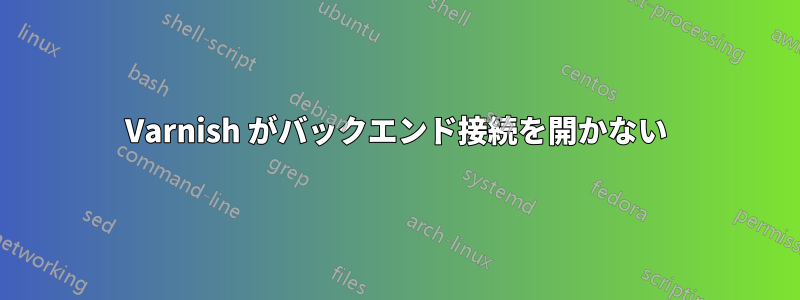
Varnish コンテナを PHP-FPM + NGINX コンテナに接続するにはどうすればよいですか? Docker は正しく起動し、サイトは機能しますが、backendopen ログは空です。
バックエンドは正常です (HTTP 200 ステータスを返します)。
varnishlog -g 生 -i バックエンドヘルス
0 Backend_health - default Still healthy 4---X-RH 7 5 10 0.048069 0.065633 "HTTP/1.1 200 OK"
http (nginx) コンテナから、docker ログにリクエストが表示されます。
docker ログ http
[10/Sep/2021:17:24:01 +0000] "GET /health_check.php HTTP/1.1" 200 5 "-" "-"
しかし、バックエンド接続は接続を開かず、ログは空で、次のように検証されます。varnishlog -i バックエンドオープンコマンド。このサイトの解決策を試しましたが、機能しませんでした:docker-compose、ubuntu18 上の Php+Nginx+Varnish。
ドッカー
http:
build:
context: docker/http
container_name: http
ports:
- 80:80
- 443:443
depends_on:
- php
volumes:
- ./project:/var/www/project
php:
build:
context: docker/php
container_name: php
working_dir: /var/www/project
volumes:
- ./project:/var/www/project
varnish:
build:
context: docker/varnish
container_name: varnish
ports:
- 6081:6081
- 6082:6082
VCL 設定:
vcl 4.0;
import std;
backend default {
.host = "http";
.port = "80";
.first_byte_timeout = 600s;
.probe = {
#.url = "/health_check.php";
.request =
"GET /health_check.php HTTP/1.1"
"Host: http"
"Connection: close";
.timeout = 2s;
.interval = 5s;
.window = 10;
.threshold = 5;
}
}
acl purge {
"http";
}
sub vcl_recv {
if (req.restarts > 0) {
set req.hash_always_miss = true;
}
if (req.method == "PURGE") {
if (client.ip !~ purge) {
return (synth(405, "Method not allowed"));
}
# To use the X-Pool header for purging varnish during automated deployments, make sure the X-Pool header
# has been added to the response in your backend server config. This is used, for example, by the
# capistrano-magento2 gem for purging old content from varnish during it's deploy routine.
if (!req.http.X-Magento-Tags-Pattern && !req.http.X-Pool) {
return (synth(400, "X-Magento-Tags-Pattern or X-Pool header required"));
}
if (req.http.X-Magento-Tags-Pattern) {
ban("obj.http.X-Magento-Tags ~ " + req.http.X-Magento-Tags-Pattern);
}
if (req.http.X-Pool) {
ban("obj.http.X-Pool ~ " + req.http.X-Pool);
}
return (synth(200, "Purged"));
}
if (req.method != "GET" &&
req.method != "HEAD" &&
req.method != "PUT" &&
req.method != "POST" &&
req.method != "TRACE" &&
req.method != "OPTIONS" &&
req.method != "DELETE") {
/* Non-RFC2616 or CONNECT which is weird. */
return (pipe);
}
# We only deal with GET and HEAD by default
if (req.method != "GET" && req.method != "HEAD") {
return (pass);
}
# Bypass shopping cart and checkout
if (req.url ~ "/checkout") {
return (pass);
}
# Bypass health check requests
if (req.url ~ "/pub/health_check.php") {
return (pass);
}
# Set initial grace period usage status
set req.http.grace = "none";
# normalize url in case of leading HTTP scheme and domain
set req.url = regsub(req.url, "^http[s]?://", "");
# collect all cookies
std.collect(req.http.Cookie);
# Compression filter. See https://www.varnish-cache.org/trac/wiki/FAQ/Compression
if (req.http.Accept-Encoding) {
if (req.url ~ "\.(jpg|jpeg|png|gif|gz|tgz|bz2|tbz|mp3|ogg|swf|flv)$") {
# No point in compressing these
unset req.http.Accept-Encoding;
} elsif (req.http.Accept-Encoding ~ "gzip") {
set req.http.Accept-Encoding = "gzip";
} elsif (req.http.Accept-Encoding ~ "deflate" && req.http.user-agent !~ "MSIE") {
set req.http.Accept-Encoding = "deflate";
} else {
# unknown algorithm
unset req.http.Accept-Encoding;
}
}
# Remove all marketing get parameters to minimize the cache objects
if (req.url ~ "(\?|&)(gclid|cx|ie|cof|siteurl|zanpid|origin|fbclid|mc_[a-z]+|utm_[a-z]+|_bta_[a-z]+)=") {
set req.url = regsuball(req.url, "(gclid|cx|ie|cof|siteurl|zanpid|origin|fbclid|mc_[a-z]+|utm_[a-z]+|_bta_[a-z]+)=[-_A-z0-9+()%.]+&?", "");
set req.url = regsub(req.url, "[?|&]+$", "");
}
# Static files caching
if (req.url ~ "^/(pub/)?(media|static)/") {
# Static files should not be cached by default
return (pass);
# But if you use a few locales and don't use CDN you can enable caching static files by commenting previous line (#return (pass);) and uncommenting next 3 lines
#unset req.http.Https;
#unset req.http.X-Forwarded-Proto;
#unset req.http.Cookie;
}
# Authenticated GraphQL requests should not be cached by default
if (req.url ~ "/graphql" && req.http.Authorization ~ "^Bearer") {
return (pass);
}
return (hash);
}
sub vcl_hash {
if (req.http.cookie ~ "X-Magento-Vary=") {
hash_data(regsub(req.http.cookie, "^.*?X-Magento-Vary=([^;]+);*.*$", "\1"));
}
# To make sure http users don't see ssl warning
if (req.http.X-Forwarded-Proto) {
hash_data(req.http.X-Forwarded-Proto);
}
if (req.url ~ "/graphql") {
call process_graphql_headers;
}
}
sub process_graphql_headers {
if (req.http.Store) {
hash_data(req.http.Store);
}
if (req.http.Content-Currency) {
hash_data(req.http.Content-Currency);
}
}
sub vcl_backend_response {
set beresp.grace = 3d;
if (beresp.http.content-type ~ "text") {
set beresp.do_esi = true;
}
if (bereq.url ~ "\.js$" || beresp.http.content-type ~ "text") {
set beresp.do_gzip = true;
}
if (beresp.http.X-Magento-Debug) {
set beresp.http.X-Magento-Cache-Control = beresp.http.Cache-Control;
}
# cache only successfully responses and 404s
if (beresp.status != 200 && beresp.status != 404) {
set beresp.ttl = 0s;
set beresp.uncacheable = true;
return (deliver);
} elsif (beresp.http.Cache-Control ~ "private") {
set beresp.uncacheable = true;
set beresp.ttl = 86400s;
return (deliver);
}
# validate if we need to cache it and prevent from setting cookie
if (beresp.ttl > 0s && (bereq.method == "GET" || bereq.method == "HEAD")) {
unset beresp.http.set-cookie;
}
# If page is not cacheable then bypass varnish for 2 minutes as Hit-For-Pass
if (beresp.ttl <= 0s ||
beresp.http.Surrogate-control ~ "no-store" ||
(!beresp.http.Surrogate-Control &&
beresp.http.Cache-Control ~ "no-cache|no-store") ||
beresp.http.Vary == "*") {
# Mark as Hit-For-Pass for the next 2 minutes
set beresp.ttl = 120s;
set beresp.uncacheable = true;
}
return (deliver);
}
sub vcl_deliver {
if (resp.http.X-Magento-Debug) {
if (resp.http.x-varnish ~ " ") {
set resp.http.X-Magento-Cache-Debug = "HIT";
set resp.http.Grace = req.http.grace;
} else {
set resp.http.X-Magento-Cache-Debug = "MISS";
}
} else {
unset resp.http.Age;
}
# Not letting browser to cache non-static files.
if (resp.http.Cache-Control !~ "private" && req.url !~ "^/(pub/)?(media|static)/") {
set resp.http.Pragma = "no-cache";
set resp.http.Expires = "-1";
set resp.http.Cache-Control = "no-store, no-cache, must-revalidate, max-age=0";
}
unset resp.http.X-Magento-Debug;
unset resp.http.X-Magento-Tags;
unset resp.http.X-Powered-By;
unset resp.http.Server;
unset resp.http.X-Varnish;
unset resp.http.Via;
unset resp.http.Link;
}
sub vcl_hit {
if (obj.ttl >= 0s) {
# Hit within TTL period
return (deliver);
}
if (std.healthy(req.backend_hint)) {
if (obj.ttl + 300s > 0s) {
# Hit after TTL expiration, but within grace period
set req.http.grace = "normal (healthy server)";
return (deliver);
} else {
# Hit after TTL and grace expiration
return (restart);
}
} else {
# server is not healthy, retrieve from cache
set req.http.grace = "unlimited (unhealthy server)";
return (deliver);
}
}
答え1
varnishlog -g request -q "ReqUrl eq '/'"ホームページをリクエストしたときに何が起こるかを確認するために実行してみてください。
キャッシュが空のときにこのコマンドを実行すると、Varnish がバックエンドに接続しようとするのがわかります。
VSL 出力をここで共有していただければ、サポートさせていただきます。
アップデート
ファイルを見ると、コンテナがポート&上のトラフィックを処理するように構成されているdocker-compose.ymlことがわかります。http80443
問題
コンテナvarnishはポート6081&でリッスンしています6082。トラフィックをポートに直接ルーティングしない限り、6081Varnish がリクエストを受信していないことは明らかです。
ソリューション
Varnish コンテナがポート で着信トラフィックをリッスンしていることも確認してください。VCL では、コンテナの80ポートを指定できます。80http
ただし、ポートの公開に関しては、httpコンテナのポート80を に転送することをお勧めします8080。これにより、同じポートにある Varnish との衝突を回避できます80。
公式のニス画像自分で構築する代わりに。
公式 Docker イメージを実行および構成する方法についてのチュートリアルは次のとおりです。参考:
TLS終了
現在、ポートはコンテナ443にリンクされていますhttp。そこで TLS 終了を処理し、HTTPS リクエストを Varnish にプロキシできる場合は、問題ありません。
そうでない場合は、実行できますヒッチコンテナTLS 終了を自動的に実行します。


